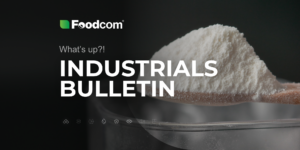- Increased demand for Primal AC261 associated with the construction and decoration season may lead to temporary stock shortages.
- Vitamin C prices have fallen, but global demand, especially for exports, remains very high.
- The availability of antimony trioxide (ATO) is declining and prices are rising dramatically due to downtime at a key producer.
- Interest in glycerin is growing, although the reasons for this trend are not yet clear – it is worth keeping a close eye on the market.
This month we focus on raw materials of importance to a variety of industries. From the versatile PRIMAL AC261 used in coatings, to the continued demand for vitamin C, to the limited supply of antimony trioxide (ATO) and changing trends in the glycerine market, we discuss everything that matters to your sourcing strategy.
PRIMAL AC261
With the onset of the spring/summer season, the demand for decorative paints, varnishes and emulsions is increasing – and consequently so is the demand for raw materials such as Primal AC261. This is a popular acrylic dispersion used in the formulation of water-based paints, with a good adhesion profile and flexibility. We are currently seeing an increased number of orders from the DIY sector and building wholesalers – which may result in temporary stock shortages at some distributors. Those in the industry who have not already stocked up on key components may face difficulties in the coming weeks.
Vitamin C
Vitamin C is currently one of the more interesting cases in the pharmaceutical and supplement market. Prices have fallen significantly compared to the pandemic period – by up to several tens of per cent – but demand remains very high from both OTC drug and supplement manufacturers. Particularly active are companies operating in export markets (Asia, Middle East), where a buying spurt is noticeable. Price reductions are mainly due to the rebuilding of supply chains in China and overproduction in some regions. For importers, this is a good time to contract larger volumes at favourable rates.
ATO (Antimony trioxide)
Antimony trioxide (ATO) is a compound of particular importance in the production of technical ceramics and specialised glazes and enamels. Although it also has applications in the plastics and fireproofing industries, it is the ceramics sector that generates the most demand today. The problem is that one of the world’s largest producers has experienced a long downturn, which has translated into a dramatic price increase – from a level of EUR 17-18/KG to as much as EUR 50-60/KG in just a few months. Raw material availability is severely limited and the market is looking for substitutes or trying to contract supplies in advance. If anyone has not yet calculated the impact of this situation on their own production – it is definitely worth doing so now.
Glycerine
In the technical and pharmaceutical raw materials market, we are seeing an increase in enquiries for glycerine. Both the technical and pharmaceutical forms of this substance are now hitting the radar of many companies – although it is not entirely clear what exactly is driving this trend. Glycerine is a very versatile product: used in cosmetics, medicines, hygiene products, household chemicals and even in the food industry. Its versatility makes it a sensitive barometer of change in many sectors. Increased interest may suggest impending turbulence in one of these areas – it is worth monitoring the situation.
NEWS
The European Union is preparing to present a proposal on 2 July to add a greenhouse gas (GHG) emissions reduction target of 90 per cent of 1990 levels to the European Climate Act, but with the addition of ‘needed flexibility’, so announces the EC’s Director-General for Climate, Kurt Vandenberghe. The new formula could involve, for example, weaker requirements for certain industries and allowing up to 3% reductions through international carbon credits – an idea supported by Germany. Although Radan Kanev (EPP) admits that most countries and public opinion do not support such a high target, the EC assures that it will be “pragmatic enough and without slowing down”. The proposal will be completed in 2026 with detailed regulations – including ETS reform and mechanisms to support industry and the agricultural sector with climate neutrality by 2050.
Japan is preparing to increase its imports of ‘grey’ ammonia by an additional 100-150,000 t/year from 2027, when Ube Chemicals will suspend operations of its 330,000 t/year plant, translating into around 40% of its domestic ammonia production. The country consumes around 1 million t of ammonia per year, with domestic production supplying 800-900,000 t and imports so far hovering around 200,000 t (dropping slightly to 140-150,000 t in 2025). With the closure of the Ube plant, Japan will have to increase imports, most likely from Southeast Asia or China. Ammonia goes primarily to petrochemical production, fertilisers, AdBlue, nitric acid, and a small portion to the semiconductor industry (~5,000 t/year). The proposal to increase imports is a response to growing demand and the trend of extinguishing in-house production capacity.
The US Energy Information Administration (EIA) has raised its forecasts for the share of renewable energy in the energy mix, with a projection of around 1.1 billion MWh (25%) in 2025 and up to 1.2 billion MWh of energy from renewable sources in 2026, giving a record 27% share. Such growth is mainly due to the ongoing expansion of solar farms (32.5 GW of new installations in 2025) and wind farms (7.7 GW), which are driving the green revolution – agro, technology and commercial – this supports the surpassing of the share of hydro by solar installations already in 2025. These optimistic projections are part of a broader trend: growing demand for electricity driven by AI and cryptocurrency data centres, which also contributes to record electricity consumption in 2025-26, while accelerating the energy transition in the US.
![What’s new in the chemical industry? Market overview and analysis [May 2025] What’s new in the chemical industry? Market overview and analysis [May 2025]](https://foodcom.pl/wp-content/uploads/2025/06/Co-nowego-w-branzy-chemicznej-Przeglad-i-analiza-rynku-Maj-2025-1520x855.png)






